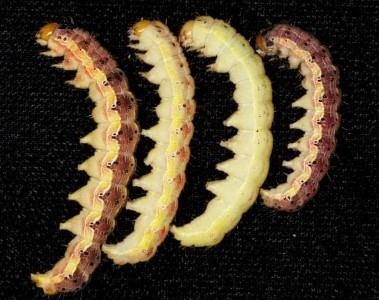The corn earworm can put plants at risk for disease. Learn to identify and manage them.
Identification

Figure 1. Adult moths are green, brown, or pink with stripes about 1.5 inches.
- The corn earworm is also called cotton bollworm, tomato fruitworm, and sorghum head worm.
- Hosts are corn, cotton, peanuts, tomato, ornamental plants, and others.
- Their appearance is green, brown, or pink with stripes about 1.5 inches when fully grown (figure 1).
- Adult moths are cream colored with irregular wing markings and are often found in daytime resting under foliage.
The Life of a Corn Earworm
- The life cycle is about 30 days.
- Multiple generations a year appear in the south.
- Corn earworms migrate during the summer and are active at night.
- Adult moths lay eggs on plants.
- Hatched caterpillars (larvae) cause damage.
- Growth is in 5 to 8 stages (instars) over about 2 weeks before they move into the soil.
Damage
- Corn earworms feed on floral material.
- They create wounds in the buds.
- This pest puts plants at risk for disease.
- Fusarium bud rot is a major issue.
- Corn earworms can produce a toxin dangerous to humans and animals.
- Avoid harvesting infected plants.
Management
- Monitor for adults using pheromone traps.*
- Use traps only for monitoring, not control.
- Scout plants often for larvae.
- Hand removal of larvae is effective.
- Alabama has insecticides approved for use in hemp.
- Insecticide efficacy data on corn earworm is minimal; contact your local Extension office for information.
Source : aces.edu